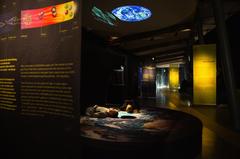Impression from the exhibition. Credit: UHH/Esfandiari
"Where do we come from, where are we going?" or "Does the universe have a beginning and an end?" - the multimedia special exhibition "How it all began" at the Museum der Arbeit will take visitors to the Big Bang and the infinity of the universe from October 26, 2022 to April 10, 2023.
The exhibition is a unique cooperation project between Hamburg's scientific institutions University of Hamburg and its Cluster of Excellence Quantum Universe with the German Electron Synchrotron DESY and the Museum of Labor. It makes top-level research in the Hanseatic city tangible for its citizens and also offers an extensive accompanying program for children and young people.
The journey to the origin of the universe takes us back more than 13 billion years. The exhibition provides exciting insights into the latest scientific findings in particle physics, astroparticle physics and cosmology and presents them in an interactive way: A spark chamber makes visible the ubiquitous radiation produced at the boundaries of our atmosphere by the impact of high-energy particles from the depths of space. In the interactive installation "Big Bang," visitors can discover the early universe and navigate through the age of elementary particles, or use the "Dark Matter Simulation" to see what effects a changing proportion of dark matter in star systems has.
Prof. Dr. Rita Müller, Director of the Museum der Arbeit: "In its exhibitions of recent years, the Museum der Arbeit has dealt with many particularly relevant topics - from the increasing importance of artificial intelligence to the role of Hamburg companies in colonialism and the handling of social conflicts. The focus of these exhibitions has been primarily on recent history and the immediate present. With the exhibition "How It All Began," the museum now invites visitors on a journey through time to the origins of our universe and presents the latest findings in physics and the work of researchers in a vivid way. I am very pleased that this extraordinary exhibition project can be seen at the Museum der Arbeit and thank all the scientific institutions involved for their great cooperation."
Prof. Dr. Hauke Heekeren, President of the University of Hamburg: "Who wouldn't want to know more about it - about the origin of our universe? Scientists feel the same way as interested citizens. For this reason, it is a very elementary part of our task as a university to open up to society and, for example, to use exhibitions and collaborations like this one to communicate our knowledge, even outside our own sphere of influence. I am very pleased about this special project by our Cluster of Excellence Quantum Universe, the German Electron Synchrotron DESY and the Museum of Labor, with which the University of Hamburg is also implementing the Excellence Strategy of the German federal and state governments."
Prof. Dr. Beate Heinemann, DESY Director for Particle Physics: "The universe exudes an almost unbelievable fascination that drives us researchers to unlock its many secrets. Where do we come from, where are we going - this research has an impact on our culture and our way of thinking. With the exhibition "How It All Began," we are taking citizens on a journey through the universe and letting them share in our research and our fascination with the universe."
Dr. Nina Lemmens, program director of the Joachim Herz Foundation: "What is our universe made of? Does the universe have a beginning and an end? - These questions are of great interest to young people in particular. I am very pleased that the Joachim Herz Foundation was able to contribute to the success of this exciting exhibition with its support. This has also resulted in guided tours for school classes at secondary level I or II and suitable digital teaching materials that can be used to prepare for and follow up on visits to the exhibition. The digitized exhibition content can also be used in lessons outside Hamburg or after the exhibition has ended. All of this vividly conveys key insights from particle physics, astrophysics and cosmology to young people."
Those who want to get an idea of the end of the universe at the end of their tour of the exhibition can choose between three possible scenarios, Big Crunch, Big Rip or Big Freeze, in a walk-through installation. To let off steam, visitors can also play a game of proton soccer or test their own muscle power by separating quarks in atomic nuclei.
The exhibition will be expanded by works by five Hamburg artists who will make questions about the infinity of the universe, the exploration of the Big Bang and the associated ideas tangible from an artistic perspective. There is also an extensive accompanying program for children and young people.
The exhibition was originally developed by the Austrian Academy of Sciences/Institute for High Energy Physics in Vienna (HEPHY) and the Natural History Museum (NHM) Vienna, where it was shown in 2016/17. Within the framework of the Cluster of Excellence Quantum Universe at the University of Hamburg, the exhibition concept was adopted and supplemented with the latest scientific findings and insights into Hamburg research in collaboration with DESY.
Sponsors of the exhibition are the Joachim Herz Foundation and the Ministry of Science, Research and Equality.
Further information:
Information about the exhibition (museum page)
"Wissenswelle": Podcast of the University of Hamburg about the exhibition and the Big Bang.
Online guide to the exhibition
Venue:
Museum der Arbeit
Special exhibition „Wie alles begann: Von Galaxien, Quarks und Kollisionen“
Wiesendamm 3
22305 Hamburg
(directly at the U-/S-Bahn station Barmbek)








